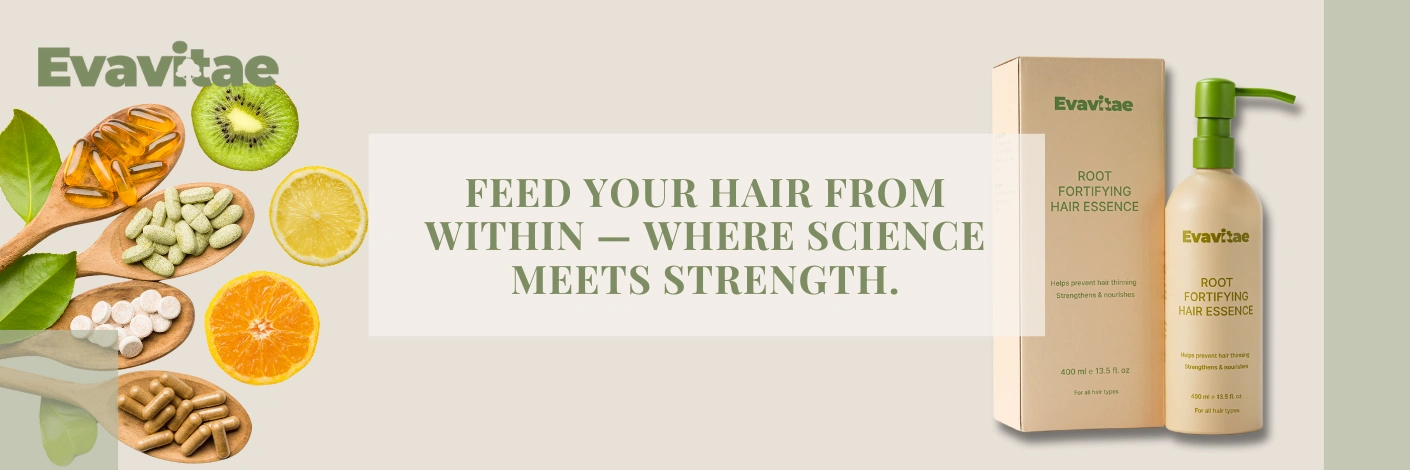
(How the Right Nutrients Help You Rebuild Stronger, Healthier Hair)
Hair loss is never just a scalp problem — it’s often a sign of internal imbalance.
Even with the best hair loss shampoo for women, results can plateau if your body lacks key nutrients for hair growth.
That’s why experts often say: “Healthy hair starts from within.”
In this article, we’ll explore how hair growth vitamins support follicle recovery, what deficiencies can lead to shedding, and how to build a complete inside-out care routine.
Related read: Scalp Care & Routine
1. Why Nutrition Is Essential for Hair Regrowth
Hair follicles are among the most metabolically active structures in the human body.
Each strand goes through a growth cycle (anagen), a resting phase (telogen), and eventually shedding (catagen).
Without proper nutrients, that growth phase shortens — and regrowth slows down.
Several studies from PubMed and Mayo Clinic confirm that deficiencies in vitamins, minerals, or protein can trigger diffuse thinning, slow regrowth, and fragile hair shafts.
Your scalp health products (like Evavitae hair loss shampoo for women) improve the external environment,
but vitamins and minerals supply the internal fuel follicles need to regenerate.
2. Key Hair Growth Vitamins (and What They Actually Do)
Nutrient | Function for Hair Growth | Where to Find It |
Biotin (Vitamin B7) | Strengthens keratin infrastructure, improves elasticity, reduces breakage | Eggs, almonds, oats, or biotin supplements |
Niacin (Vitamin B3) | Improves scalp circulation, supports oxygen flow to follicles | Tuna, chicken, peanuts |
Vitamin D | Regulates follicle cycling; deficiency linked to telogen effluvium | Sunlight, salmon, fortified milk |
Iron | Prevents anemia-related shedding; key for oxygen delivery | Red meat, lentils, spinach |
Zinc | Repairs tissue and balances oil production | Pumpkin seeds, chickpeas |
Omega-3 fatty acids | Reduce inflammation and support scalp barrier | Flaxseed, walnuts, fish oil |
Vitamin E | Protects follicles from oxidative stress | Avocado, olive oil, sunflower seeds |
Tip: Instead of chasing high-dose supplements, focus on balanced intake. Your hair follicles respond best to consistency, not overload.
Among all hair growth vitamins, Biotin often stands out — but its effects are best seen when paired with topical support. For an in-depth look, visit our article on does Biotin help hair growth and how to combine it with gentle topical care.
While internal nutrition strengthens the foundation for growth, external care is equally essential. Discover how to choose the right formula in our guide on hair loss shampoos for women and what makes them effective for faster regrowth, and natural hair products for hair growth and how clean beauty supports scalp health.
3. What Happens When You’re Deficient
Nutrient deficiencies manifest differently depending on the root cause:
- Iron deficiency: Hair becomes thin, brittle, and sheds diffusely.
- Vitamin D deficiency: Hair fails to re-enter the growth phase properly.
- Biotin deficiency: Hair looks dull, splits easily, and grows slowly.
- Protein deficiency: Follicles produce weaker strands due to lack of keratin substrates.
Research from Healthline shows that many people with chronic hair loss have one or more of these deficiencies — especially women facing postpartum, stress-related, or hormonal shedding.
Combining nutritional correction with topical care (like the Evavitae hair loss shampoo for women) ensures both the roots and scalp are supported for visible recovery.
While nutrition provides internal support, external care can amplify your results. To see which natural topical ingredients are most effective, explore our detailed review of hair growth serums for women powered by natural ingredients that actually work.
4. How to Combine Vitamins with Topical Care
Nutrition and topical care should never be isolated; they work in synergy.
Step 1: Strengthen from Within
- Add foods rich in biotin, iron, and vitamin D.
- If dietary gaps exist, consider a hair growth vitamin supplement.
Step 2: Restore the Scalp Barrier
- Use an amino-acid-based shampoo (like Evavitae hair loss shampoo for women) to remove buildup gently while retaining natural oils.
Step 3: Improve Circulation
- Massage your scalp 1–2 minutes daily to boost blood flow.
- Pair this with Niacinamide or Ginseng-based formulas that support follicle energy metabolism.
Step 4: Maintain Consistency
- Hair cycles are slow — visible change often takes 8–12 weeks.
- Document progress with photos and adjust both diet and care routine gradually.
5. How Stress and Hormones Disrupt Nutrient Absorption
Stress-related hair loss (stress hair loss female, hair loss stress female) is increasingly common —
not just because stress triggers cortisol spikes, but because it blocks nutrient absorption.
When under chronic stress, the body diverts energy away from “non-essential” functions like hair production.
Even if you take the best hair growth vitamins, your follicles might not fully utilize them.
That’s why Evavitae emphasizes whole scalp wellness: gentle cleansing, balanced nutrients, and lifestyle support — not harsh quick fixes.
6. FAQs
Q1: Do hair growth vitamins really work?
Yes, but only if the hair loss is related to a deficiency. If you already have sufficient nutrition, topical solutions may have more visible impact.
Q2: Can I take vitamins and use Evavitae together?
Absolutely. Combining hair growth vitamins with a gentle, sulfate-free hair loss shampoo for women supports both internal and external hair recovery.
Q3: How long until I see results?
Typically 8–12 weeks of consistent nutrition and scalp care. Remember, hair growth is cyclical, not instant.
7. Key Takeaways
- Inside + Outside = Real Results:
Nutrients fuel growth; shampoo maintains the scalp environment.
- Balance, not overload:
Over-supplementation can backfire; focus on steady nutrient intake.
- Consistency is everything:
Long-term results depend on regular care, not quick solutions.
For topical balance, explore Evavitae Anti-Hair Loss Shampoo —
formulated with Biotin, Niacinamide, and Ginseng Extract for gentle daily strengthening.
Explore every stage of postpartum hair recovery — causes, care, and confidence — in our Main Postpartum Hair Loss Hub.
Evavitae products are now available exclusively at www.evavitae.com.




Add comment
You must be logged in to post a comment.